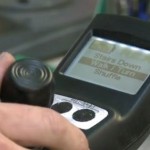Archive for Июль, 2010
A formal method for avoiding hyperstaticity when connecting an exoskeleton to a human member
- Тип контента: Научная статья
- Номер документа: 427
- Название документа: A formal method for avoiding hyperstaticity when connecting an exoskeleton to a human member
- Номер (DOI, IBSN, Патент): 10.1109/ROBOT.2010.5509346
- Изобретатель/автор: Morel, G., Jarrasse, N.
- Правопреемник/учебное заведение: CNRS, Univ. P. et M. Curie Paris VI, Paris, France
- Дата публикации документа: 2010-07-15
- Страна опубликовавшая документ: Франция
- Язык документа: Английский
- Наименование изделия: Не заполнено
- Источник: http://ieeexplore.ieee.org/search/freesrchabstract.jsp?tp=&a
- Вложения: Да
- Аналитик: Дмитрий Соловьев
 The design of a robotic exoskeleton often focuses on replicating the kinematics of the human limb that it is connected to. However, human joint kinematics is so complex that in practice, the kinematics of artificial exoskeletons fails to reproduce it exactly. This discrepancy results in hyperstaticity. Namely, uncontrolled interaction forces appear. In this paper, we investigate the problem of connecting an exoskeleton to a human member while avoiding hyperstaticity; to do so, we propose to add passive mechanisms at each connection point. We thus introduce a formal methodology for avoiding hyperstaticity when connecting wearable robotic structures to the human body. First, analyzing the twist spaces generated by these fixation passive mechanisms, we provide necessary and sufficient conditions for a given global isostaticity condition to be respected. Then, we derive conditions on the number of Degrees of Freedom (DoFs) to be freed at the different fixations, under full kinematic rank assumption. We finally apply the general methodology to the particular case of a 4 DoF shoulder-elbow exoskeleton. Experimental results allow to show an improvement in transparency brought by the passive mechanism fixations.
The design of a robotic exoskeleton often focuses on replicating the kinematics of the human limb that it is connected to. However, human joint kinematics is so complex that in practice, the kinematics of artificial exoskeletons fails to reproduce it exactly. This discrepancy results in hyperstaticity. Namely, uncontrolled interaction forces appear. In this paper, we investigate the problem of connecting an exoskeleton to a human member while avoiding hyperstaticity; to do so, we propose to add passive mechanisms at each connection point. We thus introduce a formal methodology for avoiding hyperstaticity when connecting wearable robotic structures to the human body. First, analyzing the twist spaces generated by these fixation passive mechanisms, we provide necessary and sufficient conditions for a given global isostaticity condition to be respected. Then, we derive conditions on the number of Degrees of Freedom (DoFs) to be freed at the different fixations, under full kinematic rank assumption. We finally apply the general methodology to the particular case of a 4 DoF shoulder-elbow exoskeleton. Experimental results allow to show an improvement in transparency brought by the passive mechanism fixations.
Категория: Научные статьи | Нет комментариев »
Plugfest 2009: Global interoperability in Telerobotics and telemedicine
- Тип контента: Научная статья
- Номер документа: 1675
- Название документа: Plugfest 2009: Global interoperability in Telerobotics and telemedicine
- Номер (DOI, IBSN, Патент): 10.1109/ROBOT.2010.5509422
- Изобретатель/автор: Tadano, K., Schauss, T., Peer, A., Okamura, A., Miller, L.M., Low, T., King, H.H., Kawashima, K., Ka-Wai Kwok, Jee-Hwan Ryu, Hannaford, B., Guang-Zhong Yang, Griffiths, P., Glozman, D., Farkhatdinov, I., Buss, M., Arikatla, V.
- Правопреемник/учебное заведение: Univ. of Washington, Seattle, WA, USA
- Дата публикации документа: 2010-07-15
- Страна опубликовавшая документ: США
- Язык документа: Английский
- Наименование изделия: Не заполнено
- Источник: http://ieeexplore.ieee.org/search/freesrchabstract.jsp?tp=&a
- Вложения: Да
- Аналитик: Дмитрий Соловьев
 Despite the great diversity of teleoperator designs and applications, their underlying control systems have many similarities. These similarities can be exploited to enable inter-operability between heterogeneous systems. We have developed a network data specification, the Interoperable Telerobotics Protocol, that can be used for Internet based control of a wide range of teleoperators. In this work we test interoperable telerobotics on the global Internet, focusing on the telesurgery application domain. Fourteen globally dispersed telerobotic master and slave systems were connected in thirty trials in one twenty four hour period. Users performed common manipulation tasks to demonstrate effective master-slave operation. With twenty eight (93%) successful, unique connections the results show a high potential for standardizing telerobotic operation. Furthermore, new paradigms for telesurgical operation and training are presented, including a networked surgery trainer and upper-limb exoskeletoncontrol of micro-manipulators.
Despite the great diversity of teleoperator designs and applications, their underlying control systems have many similarities. These similarities can be exploited to enable inter-operability between heterogeneous systems. We have developed a network data specification, the Interoperable Telerobotics Protocol, that can be used for Internet based control of a wide range of teleoperators. In this work we test interoperable telerobotics on the global Internet, focusing on the telesurgery application domain. Fourteen globally dispersed telerobotic master and slave systems were connected in thirty trials in one twenty four hour period. Users performed common manipulation tasks to demonstrate effective master-slave operation. With twenty eight (93%) successful, unique connections the results show a high potential for standardizing telerobotic operation. Furthermore, new paradigms for telesurgical operation and training are presented, including a networked surgery trainer and upper-limb exoskeletoncontrol of micro-manipulators.
Категория: Научные статьи | Нет комментариев »
Estimation of instantaneous tremor parameters for FES-based tremor suppression
- Тип контента: Научная статья
- Номер документа: 1287
- Название документа: Estimation of instantaneous tremor parameters for FES-based tremor suppression
- Номер (DOI, IBSN, Патент): 10.1109/ROBOT.2010.5509663
- Изобретатель/автор: Rocon, E., Pons, J.L., Gallego, J.A.
- Правопреемник/учебное заведение: Bioeng. Group, Consejo Super. de Investig. Cientificas, CSIC, Madrid, Spain
- Дата публикации документа: 2010-07-15
- Страна опубликовавшая документ: Испания
- Язык документа: Английский
- Наименование изделия: Не заполнено
- Источник: http://ieeexplore.ieee.org/search/freesrchabstract.jsp?tp=&a
- Вложения: Да
- Аналитик: Дмитрий Соловьев
 Pathological tremor constitutes the most common movement disorder, and is increasing its prevalence with ageing. Treatment forms range from drugs to surgery in those patients refractory to drugs, however, tremor is not effectively managed in about 25% of patients. According to this, new management techniques such as wearable robots that take advantage of selective biomechanical loading seem an interesting alternative. Our objective is to design robotic exoskeletons which suppress tremor, letting the user perform a voluntary movement, by means of intelligent control approaches that include accurate tremor models. In this context, we propose a two-stage algorithm for real-time estimation of time varying tremor amplitude and frequency. It is based on the assumption that tremor alters voluntary motion in an additive manner, and happens in a higher frequency band. The two-stage algorithm first generates an estimation of voluntary movement based on its inherent slower dynamics, and then removes it from the total motion, directly providing an estimate of tremor. This tremor estimation is then fed into an adaptive filter, which provides instantaneous tremor characteristics. Accurate and robust tremor amplitude and frequency estimates are obtained.
Pathological tremor constitutes the most common movement disorder, and is increasing its prevalence with ageing. Treatment forms range from drugs to surgery in those patients refractory to drugs, however, tremor is not effectively managed in about 25% of patients. According to this, new management techniques such as wearable robots that take advantage of selective biomechanical loading seem an interesting alternative. Our objective is to design robotic exoskeletons which suppress tremor, letting the user perform a voluntary movement, by means of intelligent control approaches that include accurate tremor models. In this context, we propose a two-stage algorithm for real-time estimation of time varying tremor amplitude and frequency. It is based on the assumption that tremor alters voluntary motion in an additive manner, and happens in a higher frequency band. The two-stage algorithm first generates an estimation of voluntary movement based on its inherent slower dynamics, and then removes it from the total motion, directly providing an estimate of tremor. This tremor estimation is then fed into an adaptive filter, which provides instantaneous tremor characteristics. Accurate and robust tremor amplitude and frequency estimates are obtained.
Категория: Научные статьи | Нет комментариев »
REX.Новые подробности.
- Тип контента: Новостная статья
- Номер документа: 4663
- Название документа: REX.Новые подробности.
- Номер (DOI, IBSN, Патент): Не заполнено
- Изобретатель/автор: Не заполнено
- Правопреемник/учебное заведение: Не заполнено
- Дата публикации документа: 2010-07-15
- Страна опубликовавшая документ: Россия
- Язык документа: Русский
- Наименование изделия: Не заполнено
- Источник: http://habrahabr.ru/blogs/robot/99205/
- Вложения: Не заполнено
- Аналитик: Helix
 Да, Новая Зеландия не особо часто появляется в сводках технологических новинок. Но на этот раз именно Новая Зеландия отличилась — ребята из компании Rex Bionics создали более-менее портативный экзоскелет для людей с нарушениями моторной функции нижних конечностей.
Да, Новая Зеландия не особо часто появляется в сводках технологических новинок. Но на этот раз именно Новая Зеландия отличилась — ребята из компании Rex Bionics создали более-менее портативный экзоскелет для людей с нарушениями моторной функции нижних конечностей.
Категория: REX | Нет комментариев »
An artificial exoskeleton device or an orthotic device comprising an integrated hinge structure
- Тип контента: Патент
- Номер документа: 3383
- Название документа: An artificial exoskeleton device or an orthotic device comprising an integrated hinge structure
- Номер (DOI, IBSN, Патент): EP2272471A1
- Изобретатель/автор: Roel Wirix-Speet Jens, Jari Heikki Petteri Pallari
- Правопреемник/учебное заведение: Не заполнено
- Дата публикации документа: 2010-07-09
- Страна опубликовавшая документ: Бельгия
- Язык документа: Английский
- Наименование изделия: Не заполнено
- Источник: http://www.faqs.org/patents/app/20110009787
- Вложения: Да
- Аналитик: Дмитрий Соловьев
 A pivot or hinge structure integrated into the main body of an exoskeletal, e.g. orthotic device is described as well as methods for computer aided designing and making of these devices. Computer systems and software for carrying out the methods are also described. The integrated pivot or hinge structure has a specified axis of rotation, such as one coinciding or approximating with the natural rotation axis of the ankle, knee, elbow or any other relevant joint. Preferably the pivot or hinged structure is provided with a personalised resistance to rotation. The pivot or hinge structure is a pivot or hinge comprising at least two separate cylindrical parts that rotate with respect to each other, the axis of rotation being at the centre of the cylinder. The pivot or hinge can be placed to the optimal location and orientation in regard to the limb or anatomical features observed or measured from the patient thanks to the layered manufacturing technique. The range of motion can be structurally limited if needed. This enables more possibilities for adjustment when the exoskeletal device, e.g. orthotic device is fitted to the patient to ensure a better fit and functionality.
A pivot or hinge structure integrated into the main body of an exoskeletal, e.g. orthotic device is described as well as methods for computer aided designing and making of these devices. Computer systems and software for carrying out the methods are also described. The integrated pivot or hinge structure has a specified axis of rotation, such as one coinciding or approximating with the natural rotation axis of the ankle, knee, elbow or any other relevant joint. Preferably the pivot or hinged structure is provided with a personalised resistance to rotation. The pivot or hinge structure is a pivot or hinge comprising at least two separate cylindrical parts that rotate with respect to each other, the axis of rotation being at the centre of the cylinder. The pivot or hinge can be placed to the optimal location and orientation in regard to the limb or anatomical features observed or measured from the patient thanks to the layered manufacturing technique. The range of motion can be structurally limited if needed. This enables more possibilities for adjustment when the exoskeletal device, e.g. orthotic device is fitted to the patient to ensure a better fit and functionality.
Категория: Патенты | Нет комментариев »
Статистика
Категорий: 179
Статей всего: 2,003
По типу:
Видео: 36
Выдержка с форума: 1
Контактные данные: 12
Научная статья: 1388
Не заполнено: 5
Новостная статья: 317
Обзор технологии: 42
Патент: 219
Тех.подробности: 34
Тип: 1
Комментариев: 9,122
Изображений: 3,005
Подробней...
ТОР 10 аналитиков
-
Глаголева Елена - 591
Дмитрий Соловьев - 459
Helix - 218
Ридна Украина))) - 85
Наталья Черкасова - 81
max-orduan - 29
Елена Токай - 15
Роман Михайлов - 9
Мансур Жигануров - 4
Дуванова Татьяна - 3
Календарь
Авторизация
Ошибка в тексте?
Выдели её мышкой!
И нажми Ctrl+Enter